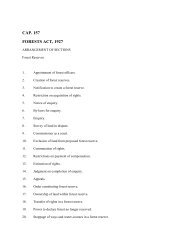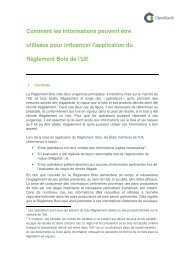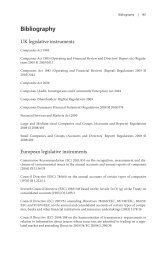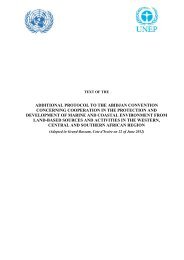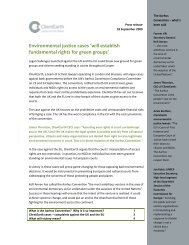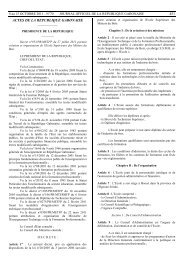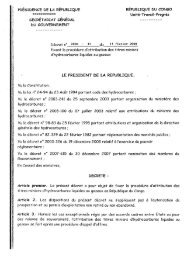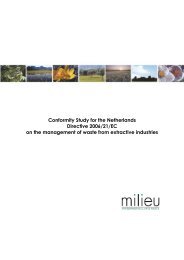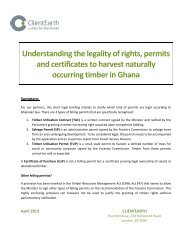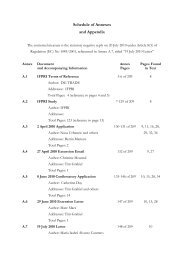Environmental and social transparency under the ... - ClientEarth
Environmental and social transparency under the ... - ClientEarth
Environmental and social transparency under the ... - ClientEarth
- No tags were found...
Create successful ePaper yourself
Turn your PDF publications into a flip-book with our unique Google optimized e-Paper software.
116 | <strong>Environmental</strong> <strong>and</strong> <strong>social</strong> <strong>transparency</strong> <strong>under</strong> <strong>the</strong> Companies Act 2006Annex 4: Auditing of company environmental <strong>and</strong> <strong>social</strong> accounting <strong>and</strong> reporting | 117explained above. However, some environmental <strong>and</strong> <strong>social</strong> informationwill fall below <strong>the</strong> threshold of what companies are required to report<strong>under</strong> section 417 Companies Act 2006. There is no legal requirement for<strong>the</strong> auditor to scrutinize this information.A.4.2AssuranceAssurance is a broader concept than audit. It is an evaluation method thatuses a specified set of st<strong>and</strong>ards to assess <strong>the</strong> quality of an organisation’sreporting, <strong>and</strong> its <strong>under</strong>lying systems, processes <strong>and</strong> culture. 294 Auditing,verification <strong>and</strong> validation are some of <strong>the</strong> tools <strong>and</strong> processes by whichassurance is obtained. It is a voluntary process for companies that wishto go beyond minimum legal requirements. It is heavily associated with‘corporate responsibility’ reporting, <strong>and</strong> providing scrutiny to this type ofnon-financial information.In <strong>the</strong> vocabulary of ‘assurance’, greater emphasis is usually placed on <strong>the</strong>needs of diverse ‘users’ of <strong>the</strong> reports. 295 It is also often framed as an aspirationalprocess, <strong>the</strong> ultimate goal being to assure all users, ra<strong>the</strong>r thansolely to certify data with a certain degree of rigour.Thus ‘assurance’ is a broader concept than ‘audit’ (perhaps most accuratelyfinancial auditing might be said to be a specific form of assurance), <strong>and</strong> ithas less clearly defined edges <strong>and</strong> limits. Its nebulous character reflects<strong>the</strong> nature of <strong>the</strong> reporting that it is usually applied to.A.4.2.1Voluntary take-up of external assurance for voluntaryenvironmental <strong>and</strong> <strong>social</strong> reportingKPMG’s periodic survey of corporate responsibility reporting in 2005296provided insight into <strong>the</strong> scale of voluntary take-up of assurance for voluntaryenvironmental <strong>and</strong> <strong>social</strong> reporting. It found that globally, anaverage of 33% of N100 297 company corporate responsibility reports containedexternal assurance statements, 298 while 54% of UK N100 companycorporate responsibility reports contained external assurance statements.Interestingly, <strong>the</strong> statistics show that large UK companies have voluntarilysought assurance statements for <strong>the</strong>ir ‘corporate responsibility’ reportingin higher numbers than <strong>the</strong> global average. 299However, <strong>the</strong> scope <strong>and</strong> methodology of <strong>the</strong> assurance is left entirely to<strong>the</strong> individual company’s discretion. Indeed <strong>the</strong> KPMG 2005 study foundin its detailed analysis of <strong>the</strong> statements of <strong>the</strong> G250 (Global Fortune 250companies), 300 that <strong>the</strong>re was considerable variation in <strong>the</strong> scope of <strong>the</strong>assurance engagement <strong>and</strong> <strong>the</strong> methodologies used, which led to greatlydivergent statements. 301 KPMG found that it ranged from scrutiny solelyof company reporting on management systems at company-selected sites,up to detailed <strong>and</strong> wide-ranging opinions on aggregated performancedata. 302 However, it found that <strong>the</strong> majority was restricted to assurance onspecific information or data sets. 303 Only 22% covered <strong>the</strong> entire corporateresponsibility report. 304While assurance has been <strong>under</strong>taken by a fair number of large companiesbased in <strong>the</strong> UK for <strong>the</strong>ir ‘corporate responsibility’ reporting, <strong>the</strong> st<strong>and</strong>ard,scope, <strong>and</strong> value of <strong>the</strong> assurance <strong>under</strong>takings are highly variable<strong>and</strong> difficult to <strong>under</strong>st<strong>and</strong>.A.4.2.2 Types of assurance providerThere are a range of external providers which carry out assurance forenvironmental <strong>and</strong> <strong>social</strong> reporting. These providers range from <strong>the</strong>major accountancy firms, such as KPMG <strong>and</strong> PricewaterhouseCoopers,to specialist corporate <strong>social</strong> responsibility (‘CSR’) consultancies suchas SustainAbility, SD3 <strong>and</strong> many o<strong>the</strong>rs worldwide. However, <strong>the</strong> majoraccountancy firms still dominate <strong>the</strong> field; in 2005, an average of 58% ofN100 companies used major accountancy firms to carry out assurance on<strong>the</strong>ir voluntary environmental <strong>and</strong> <strong>social</strong> reports. 305New types of assurance provider are also being used to provide greater (ordifferent types of) assurance. A significant example is <strong>the</strong> use of ‘StakeholderPanels’. Stakeholder panels are groups of experts, ‘stakeholders’, 306or <strong>the</strong>ir representatives who are invited by a company to examine someaspects of its policies, actions or performance <strong>and</strong> deliver reports or statementsto which <strong>the</strong> company has made a specific commitment to respond. 307While <strong>the</strong>y were originally used mostly in relation to <strong>the</strong> development ofcompany policies on corporate responsibility, <strong>the</strong>y have found increasingprominence in providing assurance for corporate responsibility reporting.308 When used in relation to reporting, a panel may be used to giveinput to determine <strong>the</strong> scope of <strong>the</strong> report, <strong>and</strong> on <strong>the</strong> extent to which <strong>the</strong>expectations of stakeholders have been met in that regard. Thus <strong>the</strong>y servea different purpose to st<strong>and</strong>ard assurance: <strong>the</strong>y usually seek to commenton whe<strong>the</strong>r <strong>the</strong> company is reporting on <strong>the</strong> right things, not whe<strong>the</strong>rthose things are being reported well. 309



